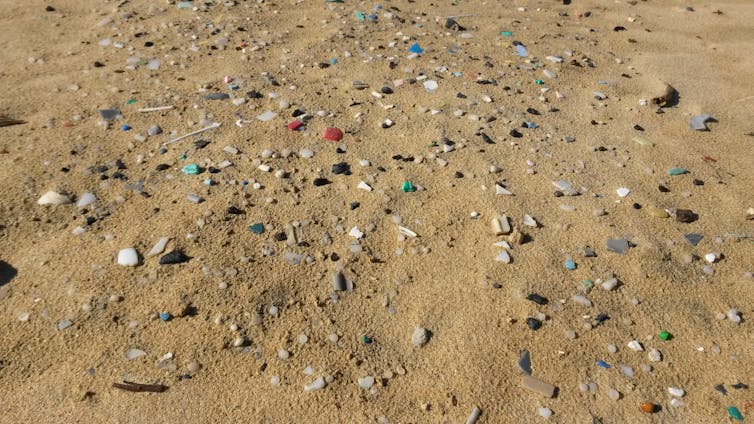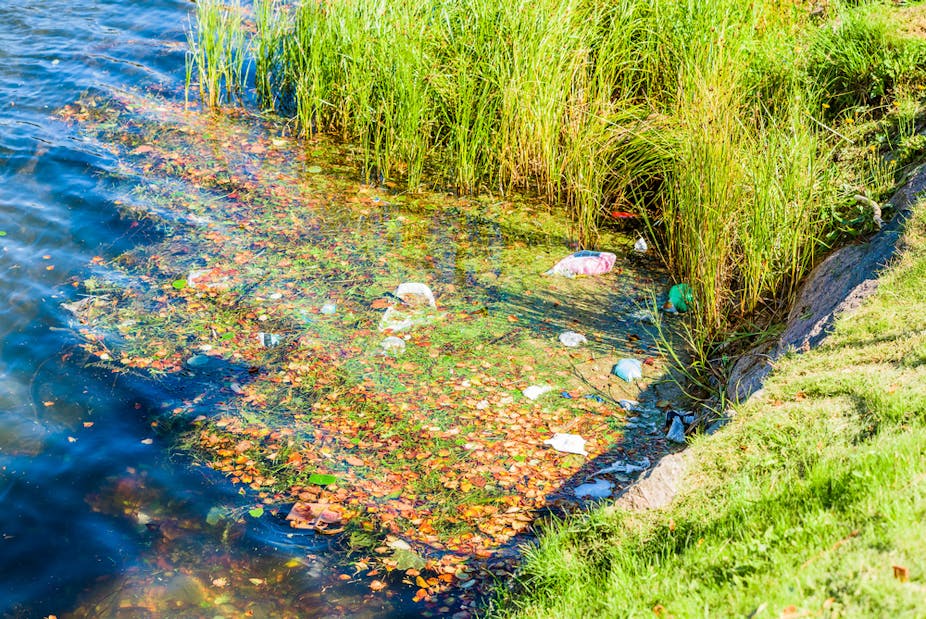Next time you take a stroll along your favourite isolated beach, far from any city, take a moment to look down at the high tide mark. You’ll almost certainly see small plastic particles dotted along your route.
These are microplastics. They’re less than 5mm in size and, for a long time, were only found in industrialised, highly populated areas.
Sadly for our oceans, things are changing. In our recent study of South Africa’s coastline, we compared popular beaches in built-up areas with more remote beaches. The aim was to see which were more contaminated with microplastics. Contamination levels were similar along the sparsely populated west coast, for example in places like Port Nolloth and Paternoster, and the more populated east coast at Salt Rock, and Port Edward. The majority of this contamination are plastic fibres potentially released during a washing machine cycle.
Microplastic pollution is a global phenomenon. Particles are found in deep sea sediment, Arctic sea ice and islands far from civilisation. Marine life of all sizes from zooplankton to whales are affected by this pollution. Ingestion of these non-biodegradeable particles reduces an organism’s ability to consume its natural prey. There also concerns about apparent toxicity. So, there’s major ecological interest around the increase of the particles as marine life suffer.
Where do they come from
The composition of microplastics are common throughout the world. Nurdles – small plastic pellets – microbeads, plastic fragments and microfibres make up the overall burden. Some areas have a higher concentration of a certain type indicating where they come from. For example, harbours have more pellets because they tend to be surrounded by factories. Waterways near populated cities may have more microbeads and microfibres as they are used and produced by consumers. Fragments may be high on polluted beaches far from populated areas since it takes some time for larger items to break down.
Industrial pellets or nurdles are used to manufacture larger plastic items. They may be introduced into nearby ecosystems through accidental losses or spillage occurring mainly during their manufacture and transportation. These pellets have a high affinity for Persistent Organic Pollutants (POP), meaning that POPs attach to the surface of the pellets, typically found at low levels in sea water. This creates a pathway for an increased concentration of toxins entering the food-web as a result of pellet ingestion.
Microbeads are often incorporated in a number of household products, like facewashes, hand and body scrubs and toothpastes. These microplastics enter wastewater treatment facilities, after being washed down the drain, and are subsequently released into nearby environments. They contain POPs similar to industrial nurdles, but also provide the ideal surface for bacteria to colonise.
Microplastics collected from an urban river in Chicago, Illinois, USA hosted a high concentration of pathogenic taxa known to cause human gastrointestinal infections. Out of concern for the freshwater and marine ecosystem the initiative Beat the Microbead was formed. It informs consumers about which products are safe to use and which to stay away from.
A number of countries, among them the United Kingdom and Canada, are moving to ban the use of microbeads in cosmetics.

Another problem
But tiny plastic particles aren’t the only problem. Secondary microplastics originate from the fragmentation of larger plastic items like plastic bottles, shopping bags, polystyrene cups and containers. These are often the most common type of plastic pollution in the marine environment. Larger plastic items enter the marine environment and undergo both chemical – photo-degradation from sunlight – and mechanical breakdown from repeated exposure to light and waves. The items degrades into smaller and smaller pieces.
Microplastic fragments may cause physical damage to various marine organisms who ingest them. Some marine creatures’ gill structures are damaged and their digestive tracts clogged. The fragments they ingest may also contain harmful additives known as plasticisers. They are also known as endocrine disruptors.
The entry of these particles into marine ecosystems can be reduced by beach clean-up programmes and the reduction of single use plastics. A recent movement to clean up Versova beach in Mumbai, which had so much litter the sand couldn’t be seen, resulted in 1,740 tons of waste being removed.
But studies have suggested that it may be what South Africans are wearing that’s polluting the beaches along the coast. Synthetic garments made of polyester blends and carpeting, may breakdown during the washing process releasing small microfibres into waterways, eventually entering the marine environment.
T-shirts, shorts, jeans and jerseys are a few examples of clothing made using polyester. Estimates suggest that the production of this plastic fibre has grown significantly and will continue to do so. Microfibres pose similar dangers to plastics like entanglement. This causes unnatural movement of smaller organisms and makes them more vulnerable to predators. Fibres may also link, forming clumps that block an organism’s intestinal tract and cause it to starve.
Between 80 to 90% of the microplastics contaminating many beaches are microfibres. There are estimates that a single item of clothing may release over 2000 microfibres per wash.
These numbers add up in a household of four, five or six. The particles in question are so small they’re not all captured by traditional wastewater treatment facilities. Even if they are removed and concentrated in the sludge, this sludge is often applied to agricultural areas. Rainfall then causes the particles to flow into nearby rivers and estuaries and into marine ecosystems.
Compacting the problem
There are ways that this problem can be managed better. These include:
1) Improving the design of synthetic materials, resulting in higher durability with less shedding of fibres.
2) Improving capture of fibres at source, like additional filters on washing machine outlets.
3) Improve wastewater treatment facility infrastructure.
4) Purchase less synthetic garments and invest in a few good quality items made from natural materials.
4) Reduce the unnecessary washing of garments.
5) Upcycle plastic waste into innovative products, like turning old t-shirts into bags.
Laws don’t change until people pressure politicians to change them. For starters, it’s up to consumers to become more conscious of their plastic footprint. By reducing microplastics and microfibres entering terrestrial, freshwater and marine environments, we’ll be better able to maintain resources that humans all over the globe depend on.

